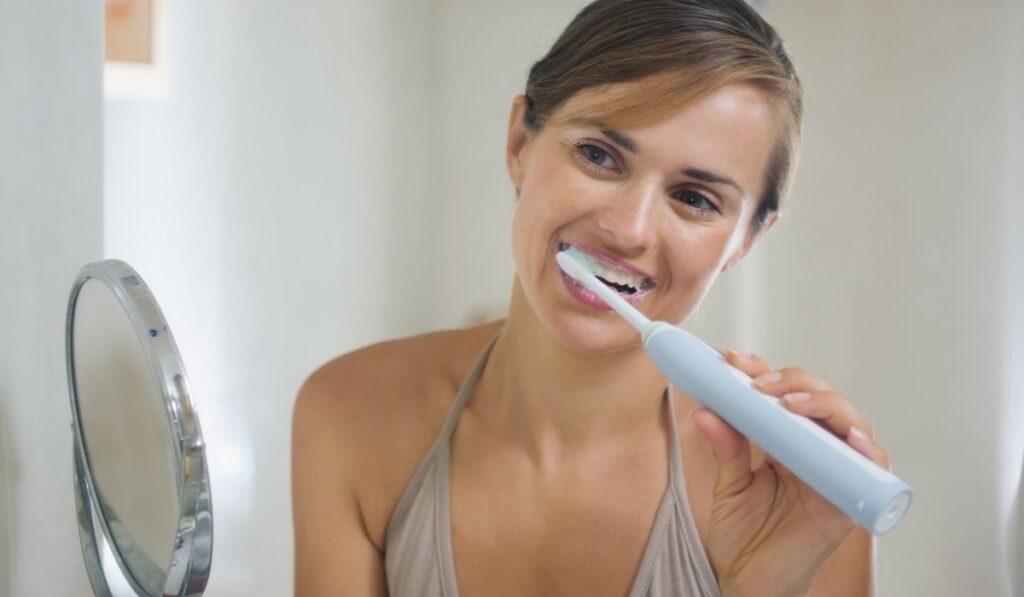Electric toothbrushes are all the rage in the world of teeth. They’re effective at removing plaque, easy to use, and fun. They also often come with added features like a timer to help you brush for the required amount of time. But what if you’ve got a crown or multiple crowns on your teeth? Can you still brush with an electric toothbrush?
Using an electric toothbrush with a permanent crown is safe and shouldn’t cause any issues. However, you should avoid using an electric toothbrush on a temporary crown, which is more susceptible to damage. For temporary crowns, stick to a soft-bristled manual toothbrush.
Beyond being safe to use on permanent crowds, electric toothbrushes can bring about significant improvements to your oral health. Let’s take a look at some of the benefits of electric toothbrushes and when you should or shouldn’t use them with crowns.
Advantages of Using Electric Toothbrushes

Although many people may consider electric toothbrushes to be an unnecessary upgrade, there are a handful of important benefits that anyone can get from using one. Here are just a few:
Keep Your Teeth and Gums Healthier
Manual toothbrushes may not fully remove the plaque or food debris in our teeth, especially if used improperly. An electric toothbrush, however, uses rotating bristles that are constantly in motion. These motions are strong enough to clean the plaque and food debris in your teeth.
An electric toothbrush also provides good pressure that helps to clean all parts of the teeth equally. Manual toothbrush users often end up brushing one side of their mouth more thoroughly; for example, right handed people often brush the left side of their mouth more thoroughly.
Less Manual Work
It’s true that a manual toothbrush makes you do all the work, whereas an electric toothbrush does it automatically. Although they may not be aware of it, people often don’t apply the same amount of time, pressure, or effort in certain areas while using a manual brush.
Electric toothbrushes have rotating bristles that operate at a consistent speed and rate, which means all you have to do is place the brush on your teeth and let the brush do the rest.
Many toothbrush models, including the popular Philips Sonicare 4100 (on Amazon), also have a built-in timer that helps you brush for the recommended two minutes.
Minimize Chances of Gingivitis and Gum Disease
Gingivitis and gum disease start to develop when there is food stuck in areas where a toothbrush can’t reach. When this food gets stuck, it starts to form plaque and cavities that ultimately lead to problems such as gum disease.
An electric toothbrush doesn’t have to rely on the manual motions of brushing and therefore ends up cleaning all parts of your teeth equally; this minimizes the chances of leftover food particles and helps prevent gingivitis and gum disease formation.
Nonetheless, a toothbrush, electric or not, will not clean between the teeth — so keep flossing!
Kids Like Them!
Convincing children to brush their teeth at least twice a day can often be a challenging task. However, electric toothbrushes have shown to boost kids’ interest in brushing and their brushing times.
Kids tend to find an electric toothbrush more intriguing than a manual one, which means they look forward to brushing their teeth more often.
An electric toothbrush also does a better job at cleaning the kids’ teeth since it’s automatic and does not rely on manual brushing or motions.
Can an Electric Toothbrush Damage Your Crowns?
While many may think that electric toothbrushes can damage crowns or any other dental treatment, that’s not actually the case. On the contrary, crowns are very tough and can withstand the effects of an electric toothbrush.
Crowns are designed to be tough, and the manufacturers know that electric toothbrushes are something people commonly use. Moreover, you can chew food on crowns and they’re good to go. Therefore, the bristles of an electric toothbrush should not damage your crowns.
Reports have shown that use electric toothbrushes with crowns for years, and even decades, with absolutely no signs of abrasion or damage.
The vibrations of an electric toothbrush are also carefully designed to only remove plaque and not loosen or damage any dental work. The bristles of a regular toothbrush can also be quite hard, which can damage your teeth, so be sure to select a toothbrush or brush head that has soft or extra soft bristles, such as the Oral-B Sensitive Gum Care Head (on Amazon).
However, if you want to take special care of your dental work, there are a few things you can avoid. These include extra-whitening toothpastes and alcohol-based mouthwashes, which can weaken the bonds in porcelain.
Can You Use an Electric Brush With Temporary Crowns?
While an electric toothbrush is completely fine to use with a permanent, solid crown, things are different when it comes to a temporary crown.
The high vibrations and oscillations of an electric toothbrush can weaken a temporary crown and make it loose. The vibrations can also cause the temporary crown to get dislodged and eventually fall out.
For this reason, dentists recommend using a manual, soft bristle toothbrush when it comes to brushing your teeth with a temporary crown. According to dentists, you should spend a little extra time around the tooth with the temporary crown and brush carefully, making sure you clean it properly while at the same time not too harshly.
Once you get permanent crowns, then you can go back to or start using an electric toothbrush and it should be no problem at all.
When it comes to temporary crowns however, there are a few other things you should be careful of other than using electric toothbrushes.
Flossing aggressively around your temporary crown is another practice that’s best to avoid. While flossing around the temporary crown, you can accidentally get the floss stuck or pull out the temporary crown. Once pulled, or loosened up, the crown can dislodge or fall out completely. Therefore, when flossing around a temporary crown, be sure to take your time.
Clenching your jaw or grinding your teeth are things you should also be aware of while you have a temporary crown; be sure to discuss this with your dentist if you know it’s something you do.
When you start to bear down stress or pressure on your crown, it may start to crack or break up. You can also chip the sides of your crown by doing this.
How to Care for Your Dental Crowns

Dental crowns can be essential in restoring and caring for damaged teeth, but they need to be looked after as well.
Although porcelain and ceramic crowns won’t decay, they still require care. A good home care routine will help prevent plaque buildup around the crown, reduce the risk of decay, and support a longer success rate for your crown.
Once the natural tooth is damaged and weakened, it can then damage the crown on it as well, therefore it’s essential to keep your crowns clean.
If the crown is not cleaned properly, it can lead to severe issues. Gum disease can develop and it can cause a range of minor and more severe issues. Gum disease can also spread into the gum tissue and even into the bone surrounding your tooth and its roots.
Cleaning your crown and teeth isn’t as complicated as it may sound; all you have to do is brush your teeth using a soft bristle brush. Flossing your teeth daily is another important part of maintaining your oral hygiene and taking care of your crown.
Dentists also recommend professional cleaning, exams, and routine x-rays to ensure your oral health and the proper examination of teeth and dental work.


